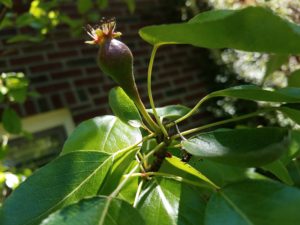If I had lived in the Holy Land in ancient times, I would have tied a tiny ribbon of reed around the stems of my budding fruit, my wheat, barley, grapes, figs, pomegranates, dates or olives. And when they were ripe, at about this time of year, I would have packed them into baskets as ornate as I could afford, loaded onto the backs of animals with horn tips painted gold, and accompanied them in a stately but also joyful and musical procession, stopping every afternoon in towns large and small along the way to Jerusalem, where I would have offered them at the Holy Temple as First Fruits to the Lord.
A priest would have taken the basket from me, and I would have recited these words:
“An Aramean [sought to] destroy my forefather, and he went down to Egypt and sojourned there with a small number of people, and there he became a great, mighty and numerous nation. The Egyptians treated us cruelly and afflicted us, and they imposed hard labor upon us. So we cried out to the Lord, God of our fathers, and the Lord heard our voice and saw our affliction, and our oppression. The Lord brought us out from Egypt with a strong hand an with an outstretched arm, with great awe, and with signs and wonders. And He brought us to this place, and He gave us this land, a land flowing with milk and honey. So now, behold, I have brought the first of the fruit of the ground which You, O Lord, have given to me.
“Then, you shall lay it before the Lord, your God, and prostrate yourself before the Lord, your God. Then you shall rejoice with all the good that the Lord, your God, has granted you and your household – you, the Levite, and the stranger who is among you.” (Deuteronomy 26:5-12)
This was the honor shown to the gift of the fruit of the Earth by our ancestors.
But by drawing into the offering this remembrance of the Exodus from Egypt, perhaps more is implied here even than gratitude for the abundance of food, and even more than the “feeding” of this abundance to the holy priests, who were the ones who were alone permitted to eat the First Fruits, signifying, perhaps, the renewal of the holiness “cycle,” if you will.
For me, it is deeply meaningful that we are called to contemplate, through the insertion of this enigmatic text, the resonance between the narrative of slavery, exploitation, and exile brought about by the descent into Egypt, and the narrative of the ultimate destination of that journey of redemption, which is the land of First Fruits. The people who offer their First Fruits with beauty and joy reflect a holy and fully embodied relationship with the land, a land which they perceive and acknowledge as the medium through which God brings blessings into the world, a land in which exploitation is rejected, a land which is to be used in partnership with the Divine to sustain all life, the smallest and most vulnerable especially.
We have so much to learn from these texts about how to bring this sensitivity and these practices into our lives. I love this season of Shavuot and First Fruits for reminding me of the beauty and generosity of the Earth and God, and for reconnecting me with the inspiration of our beautiful sacred texts.

